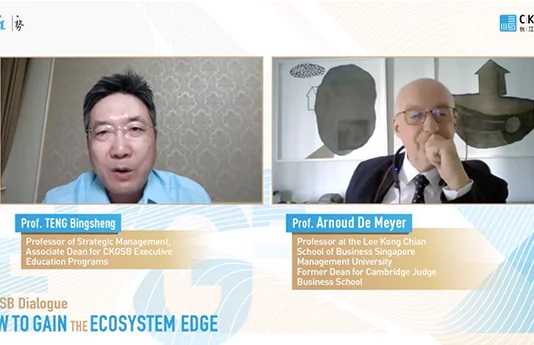In the first part of this two-part series, we found that many – maybe even most – business teams are dysfunctional. Whether your teammates are co-founders of a startup or the C-suite of a Fortune 500 company, the evidence suggests you are probably not working together as productively as you might.
Outsized egos and mis-sized groups are the most frequently cited cause of team dysfunction, as noted in part 1, but they aren’t the only problem.
Often, the difficulties start at the very beginning, because people don’t spend enough time thinking through their reasons for getting together, according to Edward Hess, Professor of Business Administration and Batten Executive-in-Residence at the University of Virginia’s Darden Business School. “One of the big mistakes that I see often is that project teams do not before beginning the project ‘make meaning’ together about the ‘why’ and the ‘what’ of the project and as importantly, they do not work out before they start the project their ‘rules of engagement’ – how they will behave in the collaborative process of working together,” he explains.
Bad manners are a second source of tension. A study Google released in 2015 that tried to weigh the factors behind the success of 180+ active teams of Google employees found that the biggest factor leading to underperformance was “a lack of psychological safety.” Afraid of the response they might get to their ideas, team members who feel threatened tend to keep their contributions to a minimum.
Managers bear a lot of the burden of creating that environment of safety – and their failure to do so tends to lead to turnover in the corner office. “I rarely come across somebody who is fired because of incompetence,” says Ray Williams, a Vancouver, B.C. author and executive coach. “That hardly ever happens. They’re fired because of their incompetence in dealing with people…”
But if interpersonal dynamics have been an issue for teams since “the Friends of Khufu” and the “Drunkards of Menkaure” built the Pyramids, other factors do seem to be making teamwork more difficult.
After conducting 6,000 hours of research that investigated team performance at 40 companies, researchers for Pearl HPS, a Silicon Valley software company that specializes in predictive analytics for teams, found that the biggest predictors of team success boil down to three metrics the company refers to as Team Leadership Capability, Team Continuity, and Team Goal Load.
Fifteen different qualities go into the company’s definition of team leadership capability, including the ability of individual team members to take risks and their propensity to identify new opportunities.
The other two metrics, however, have more to do with managerial decisions rather than managers: Team Continuity refers to the length of time that a given team has worked together, while Team Goal Load refers to the number of other teams to which team members belong.
Both metrics reflect the growing risks that cross-functional teams represent to company performance, according to Gene Tange, CEO of PearlHPS. Between moving team members from project to project and allowing them to serve on as many as 12 different teams simultaneously, supervisors often inadvertently cause the underperformance that the formation of cross-functional team is meant to avoid.
Given those challenges, how do you make sure your team succeeds?
As with startups, the size of the team should vary by the task. Robin Dunbar, an anthropologist at Oxford University and the theorist behind the Dunbar’s number – an observation that human beings can maintain stable social relationships with no more than 150 people – wrote in an email that “There are very distinct sizes for human groups that seem to work best. Which size is appropriate for a given task depends on the demands of the task. For tasks that require intimate knowledge of how the others work, only small groups (of 5) are possible; for less close interaction, bigger groups will work.”
One factor that may weigh in your decision is how original you want to be. If you want to improve a process incrementally, organize a big group. To find something radically new, the odds are relatively better with a very small team. In a joint University of Chicago and Northwestern University study published recently in Nature magazine, researchers analyzed 65 million papers, patents, and software products published between 1954 and 2014 and concluded that regardless of the discipline, groundbreaking science tends to be the product of the happy few.
Across those five decades, they wrote, “smaller teams have tended to disrupt science and technology with new ideas and opportunities, whereas larger teams have tended to develop existing ones.
Darden’s Hess suggests that teams should discuss their rules of engagement when they first begin meeting. “Those rules should promote behaviors that enable effective collaboration and minimize the big inhibitors of effective collaboration: ego, fear, and corporate politics, games and competition,“ suggests Hess. Williams says he tries to teach the executives he advises to “learn to talk less and listen more” and make sure in meetings that it’s clear that they have no favorites.
Although Peter Drucker, the management thinker, didn’t necessarily see teams as a special concern of managers (“Most human work is carried out in teams,” he wrote in 1993. “Hermits are exceedingly rare.”), he still thought that managers could help them function better. One key Drucker commandment for successful teamwork, according to Bruce Rosenstein, author of Create Your Future the Peter Drucker Way, is taking “information responsibility”, that is, “to consider to whom you owe specific information, and by what time; and who owes this information to you.” One way to encourage more of this community spirit is to compensate people less for their individual performance than for the success of their group. A recent Deloitte study found that compensation and rewards that go to the team equitably rather than being distributed to a few star performers tend to encourage more teamwork.
Often, team leaders are task-driven, according to Williams, “but they lack the sophistication in learning how to work on motivation, positive feedback, encouragement, accountability – all those kinds of things. And that shows up in the team when they don’t work very well together.
Positive comments tend to encourage better performance than negative ones: In his 2005 book, The Ape in the Corner Office: Understanding the Workplace Beast in All of Us, author Richard Conniff notes one study by Perot Data Systems that found high performance teams averaged 5.6 positive interactions for every negative one, while teams with lower levels of positive communication also tended to have lower levels of performance.
Anthropologists at the University of California at Berkeley studying winning basketball teams have found that winners tended to have many more “fist bumps, high fives, chest bumps, leaping shoulder bumps, chest punches, head slaps, head grabs, low fives, high tens, half hugs, and team huddles” than losing teams. While not all those behaviors will translate well to the office, one MIT Media Lab study found that as much as 35% of variation in team performance depends on face-to-face exchanges between team members.
Of course, the fact that teams are often not together in the same office or even on the same continent can make high fives and eye contact difficult. In that case, Williams suggests, spend more time on chit-chat in order to build up more of a rapport.
At the same time, it’s easy to have too much of a good thing. “One of the things I work with CEOs on is to reduce the number and length of meetings,” says Williams. “The number one complaint that most employees have is, ‘We meet too often. Let me get my work done.’”
In the future, technology seems likely to alter team dynamics even more, in ways that will make teamwork both more challenging and easier.
On the one hand, the amount of physically distributed collaborative work is likely to increase. Seventy percent of executives polled in Deloitte’s 2018 Global Human Capital Trends report said they believe workers will spend more time on collaboration platforms in the future.
On the other, technology will also help save us from ourselves. Advanced analytics are already beginning to play a role in assessing and improving team performance. Pearl HPS’s software, for example, is already working to predict the likelihood of team success, based on the firm’s research into the factors that contribute to team failures.
Some of the bots may soon be sitting down at the table as well. “Think of a large mural that has several artists,” says Benn Konsynski, the George S. Craft Distinguished University Professor of Information Systems and Operations Management at Emory University’s Goizueta Business School. “Even the great artists always had assistants. In the future, more of that assistance will be AI-powered. Humans guide purpose – so far – but assembly, integration, testing, and quality assessment will be increasingly dependent on machines.”
And our silicon colleagues are likely to be very helpful – at least until HAL decides we’re jeopardizing the mission.
In Part 3 of Go Team! we interview Ray Williams, a Vancouver, B.C. author and executive coach, on how executives can improve their team management skills.

















